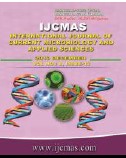


 National Academy of Agricultural Sciences (NAAS)
National Academy of Agricultural Sciences (NAAS)

|
PRINT ISSN : 2319-7692
Online ISSN : 2319-7706 Issues : 12 per year Publisher : Excellent Publishers Email : editorijcmas@gmail.com / submit@ijcmas.com Editor-in-chief: Dr.M.Prakash Index Copernicus ICV 2018: 95.39 NAAS RATING 2020: 5.38 |
Present study was conducted to assess the nutritional status of 600 elderly populations residing in urban (200), rural (200) and tribal area (200) of Nanded district of Marathwada region of Maharashtra state, India. Anthropometric status of selected elderly was determined by recording height (cm), weight (kg), hip circumference (cm), waist circumference (cm) and body mass index was calculated using values of height and weight. On the basis of BMI, selected subjects were categorised under different grades of under nutrition. Daily food intake of each selected elderly was recorded with the help of two days dietary recall method and weighment method. By using food consumption table of ICMR the nutrient intake of the elderly was calculated. Food intake was compared with balanced diet and nutrient intake was compared with the ICMR recommended dietary allowances (ICMR 2012) to find out the percent adequacy in consumption. Result revealed that the values for height of vegetarian and non-vegetarian elderly from urban, rural and tribal area ranged from 150.87±7.97 to 161.59±7.95 cm. While weight ranged from 44.53±8.57 to 60.75±10.91kg. More percent (28%) of elderly from non vegetarian food habit were found to be underweight. On the contrary, more percent of vegetarian elderly subjects were overweight than non vegetarian elderly. Selected vegetarian elderly subjects were consuming significantly more cereals (230.88±81.50 gm). Highest percent adequacy was noted for sugar and jaggery in both groups. Intake of different nutrients was found to be more among vegetarian elderly. Highest percent adequacy was noted among vegetarian elderly for fat (112.84%) and lowest percent adequacy was noted among non vegetarian elderly for calcium (26.95%).
 |
 |
 |
 |
 |